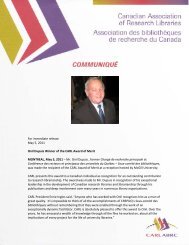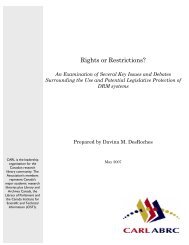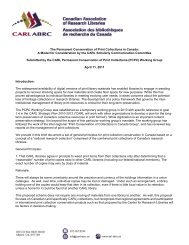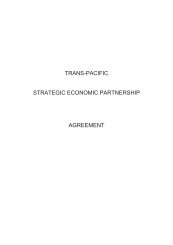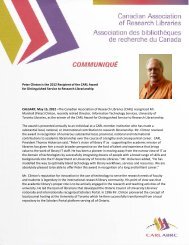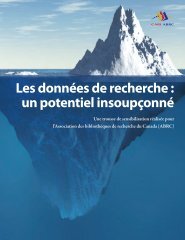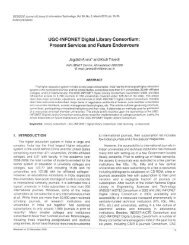PDF - CARL - ABRC
PDF - CARL - ABRC
PDF - CARL - ABRC
Create successful ePaper yourself
Turn your PDF publications into a flip-book with our unique Google optimized e-Paper software.
Outline – Synergies Business and Sustainability Plan Rowland Lorimer 5 of 11<br />
opportunities for a richer representation of researcher and hence a transformation in the<br />
nature of knowledge. It is this last point that is most persuasive in justifying investment in<br />
the technological modernization of research knowledge publication and dissemination<br />
that Synergies represents. We will come to know our world through different forms and<br />
symbols and that world will be different.<br />
Current Realities in Scholarly Communication: An Environmental Scan<br />
The creation and communication of the research record, and the resulting formation of<br />
research communities, has been vested primarily with scholars and their associations and<br />
facilitated by universities. The following describes those involved and their roles.<br />
Responsibility for the research record has been taken up at least eight categories of<br />
participants in a shared fashion. The roles of eight participants are as follows:<br />
1. Disciplinary associations found, organize, and oversee the operations of journals.<br />
2. Scholars, acting alone or in groups;<br />
a. found, organize, and oversee the operations of journals;<br />
b. volunteer as editors and on editorial boards;<br />
c. pay membership dues to associations for which members receive a<br />
subscription to the association journal;<br />
d. subscribe to journals;<br />
e. conduct research into and make innovative contributions to the scholarly<br />
publishing process.<br />
3. Universities that employ academic editorial scholars contribute by:<br />
a. allowing for such volunteerism;<br />
b. providing subsidies in the form of<br />
i. direct funding,<br />
ii. course releases,<br />
iii. space etc,<br />
iv. office services, and<br />
v. editorial assistance.<br />
4. Research institutes, sometimes in conjunction with their universities, also provide<br />
subsidies in various forms for production.<br />
5. Research funding agencies provide direct funding to journals and/or indirect<br />
funding to authors that is passed on to journals.<br />
6. Libraries act as collection-building agents, provide access, and preserve the<br />
record and thus act as representatives of users-over-time.<br />
7. University students contribute<br />
a. through the purchase of course packs where the route of the funding is<br />
often through Access Copyright. Relatively rare cases of student<br />
subscribers also exist; and<br />
b. by acting as assistant editors and fulfilling other roles in journal<br />
publishing.<br />
8. In cooperation with scholars, commercial organizations act as<br />
a. for-profit publishers of journals;<br />
b. aggregators who provide online publishing and/or dissemination services<br />
and return small revenue percentages to journals; and<br />
5/5/10 5 of 11



